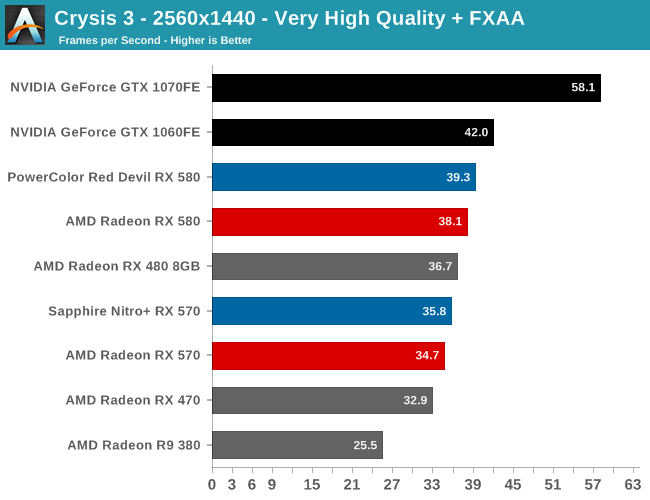The AMD Radeon RX 580 & RX 570 Review: A Second Path to Polaris
by Ryan Smith on April 18, 2017 9:00 AM EST- Posted in
- GPUs
- AMD
- Radeon
- Polaris
- Radeon RX 500
Crysis 3
Still one of our most punishing benchmarks 3 years later, Crysis 3 needs no introduction. Crytek’s DX11 masterpiece, Crysis 3’s Very High settings still punish even the best of video cards, never mind the rest. Along with its high performance requirements, Crysis 3 is a rather balanced game in terms of power consumption and vendor optimizations. As a result it can give us a good look at how our video cards stack up on average, and later on in this article how power consumption plays out.












129 Comments
View All Comments
BrokenCrayons - Tuesday, April 18, 2017 - link
The acoustics are superb! Buuuuut, the problem is that we're already looking at vendor boards so that might not be the case for every 580 and 570 out there since there'll probably be a variety of different cooling solutions in the wild.nathanddrews - Tuesday, April 18, 2017 - link
Most definitely, but for an aggressively OC air-cooled model to be quieter at load than a 950 and be over 10dBA quieter than the reference 470/480, AIB partners would have to really do something wrong to make a loud card. I'm sure it will happen, but it would have to be like a 40mm, single-slot design or something... hahaMr Perfect - Tuesday, April 18, 2017 - link
What I'd like to know is why did a 6% increase in clocks cost a 23% power increase? That seems unusually high, unless Polaris was up against the wall already in the 400 series.rarson - Tuesday, April 18, 2017 - link
I think you answered your own question..."Polaris was up against the wall already in the 400 series."
Samus - Tuesday, April 18, 2017 - link
I think the most revolutionary inclusion in this Polaris revision is the memory state (especially since little else is changed)And I use the word revolutionary because this is an eye opening reception for AMD and Intel (and nVidia) on the computing front. Imagine variable clock speeds for memory, and even overboost/turbo mode for memory for momentary spikes in demand. The voltage savings combined with the marginally added boost performance wouldn't be something to right off in the grand scheme of things. I suspect we will see this technique adopted across the board soon.
JoyTech - Tuesday, April 18, 2017 - link
Is there any data for release of Vega GPUs?Ryan Smith - Tuesday, April 18, 2017 - link
AMD's last comment was Q2 of this year.vladx - Wednesday, April 19, 2017 - link
So 99% it will be released in June.hoohoo - Tuesday, April 18, 2017 - link
Still should have called them 475 and 485. This is underwhelming. It seems like the performance bump is all from clocks. The process is perhaps able to handle higher voltages, thus slight clock bump. 2.5 slot coolers are not good.DanNeely - Tuesday, April 18, 2017 - link
These cards are to keep the OEMs happy. Even if it's the exact same product under the hood, they need a new model year to feed their marketing/sales channels. The people in them aren't gamers and PC enthusiasts who roll their eyes at this sort of thing; they're rebooting their tablets by flipping them upside down and shaking them.http://dilbert.com/strip/1995-04-03
The Vega cards we're all looking forward to will presumably be launching under 590 and Fury brandings later.